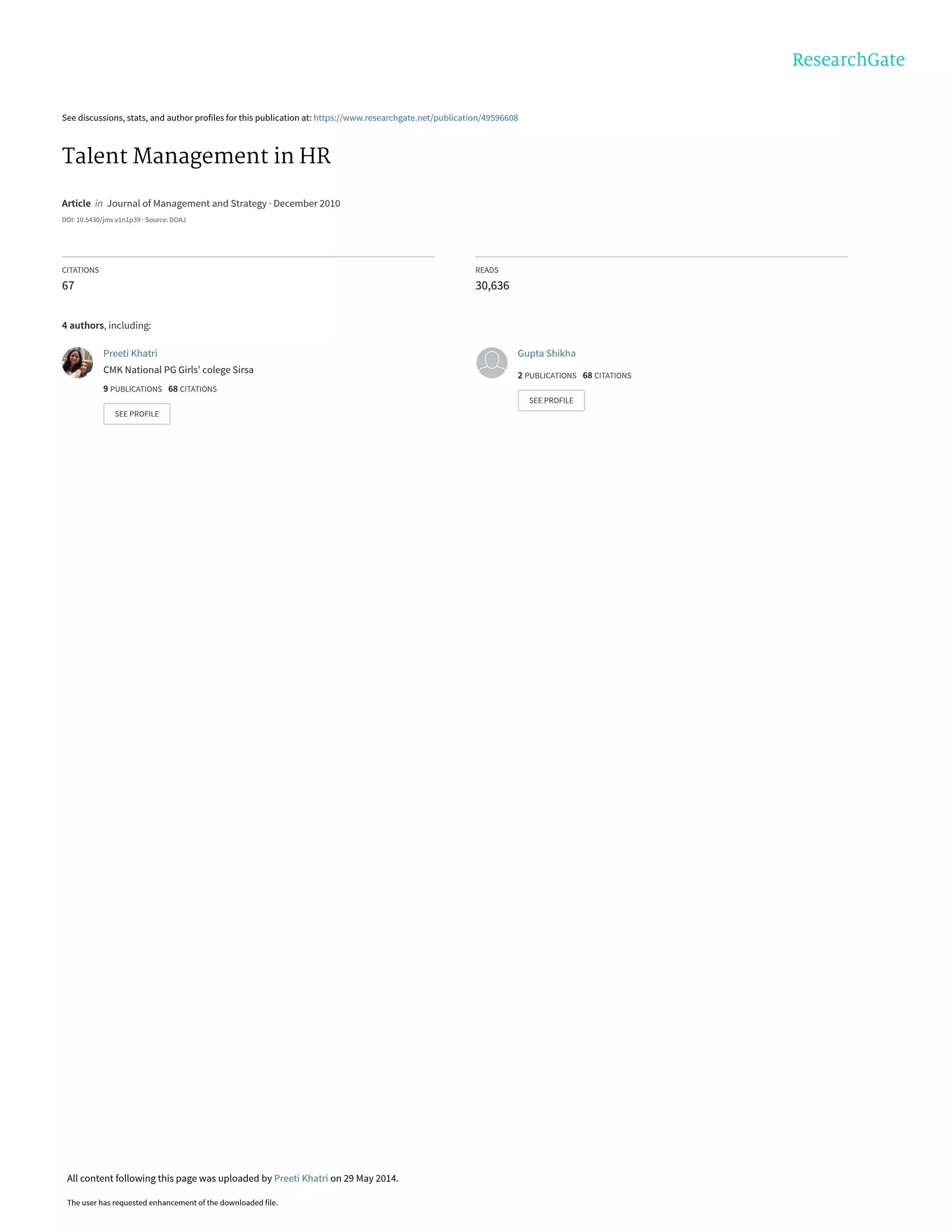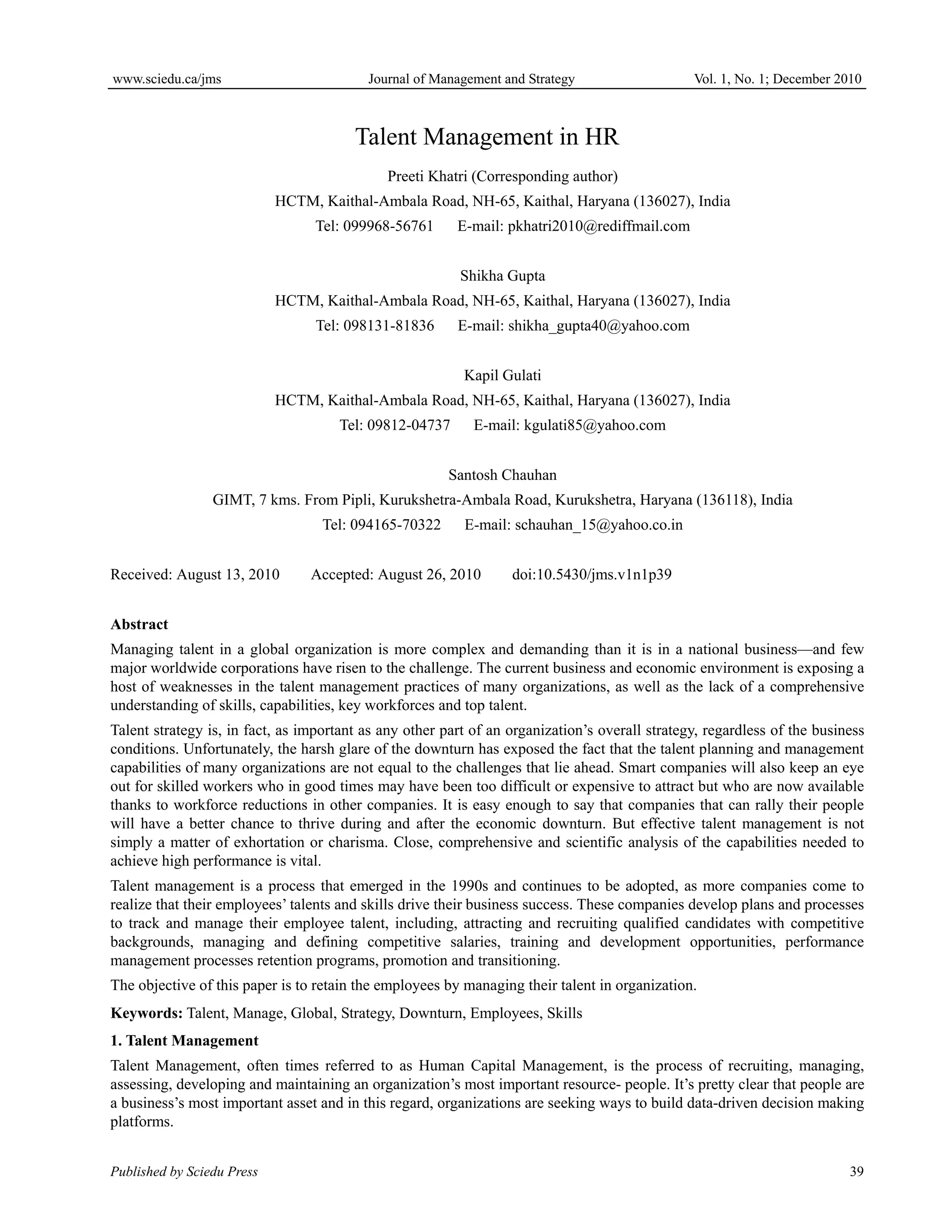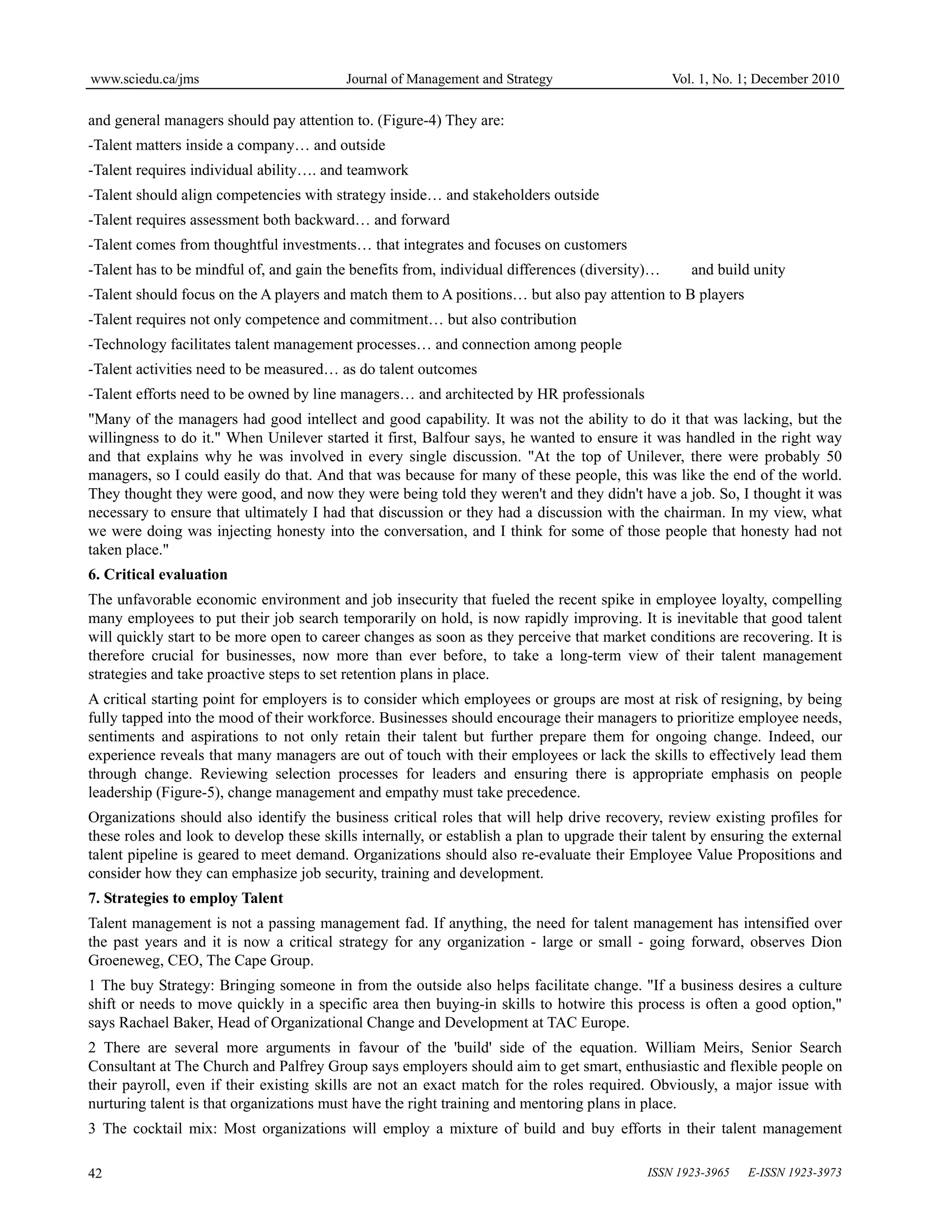This document discusses talent management strategies for organizations. It defines talent management as the process of recruiting, developing, and retaining an organization's most important asset - its people. The document outlines five rules for effective talent management: 1) Invest differently in talent segments to optimize results 2) Measure programs' business impact 3) Let numbers drive talent decisions 4) Build adaptable skills 5) Simplify performance management. It emphasizes aligning talent strategies with business goals and using data-driven approaches. Effective talent management is important for organizational success, especially during economic changes.






![www.sciedu.ca/jms Journal of Management and Strategy Vol. 1, No. 1; December 2010
ISSN 1923-3965 E-ISSN 1923-3973
44
Try defining your company's talent brand. What are the skills and behaviors that define the talent your organization
needs to achieve its goals and ambitions? Let me know how it works!
9. Conclusion
Harvard Business Review points out that, in the best of talent management programs, organizations “integrated talent
management, succession planning and leadership development into the company’s strategic business processes. When
the process runs smoothly, [companies] have a clear sense of whether their leadership teams will be able to execute on
future strategic initiatives.”
It is management, therefore, not HR, who should feel responsible for ensuring that the company defines clear job roles –
outlining necessary skill levels and competencies for each – and determine the appropriate incentives, rewards and
compensation and set the metrics by which success will be measured. In many leading organizations, management
establishes the necessary parameters which ensure that the organization has the right person with the right skills in the
right job at the right time to reach strategic goals at all levels.
Whether corporate leadership will make the investments in time to drive a successful talent management program
throughout the company? In the final analysis, though, it seems logical that businesses only stand to benefit from the
resurgence of talent management techniques and technologies.
“Properly thought through,” concludes the Harvard Business Review, “talent management can be a major part of a
company’s value proposition and a distinct competitive advantage.” One thing to consider is that your strategies must be
flexible enough to address employee age, culture and personalities, globalization, industry consolidation and, the
near-perfect communication and connectivity that social software delivers.
References
Cheese, P., Farley, C. S., and Gibbons, A. The new talent equation, [Online] Available:
www.accenture.com/.../Accenture_Outlook_The_New_Talent_Equation.pdf
Current Research in Talent Management, [Online] Available:
http://www.insala.com/Articles/talent-management/current-research-in-talent-management.asp (December 01, 2005).
Howell, Paul (2010), Time for action - Talent managers get a wake-up call, [Online] Available:
http://www.hrmasia.com/resources/talent-management/time-for-action-talent-managers-get-a-wake-up-call/46153 (02
Jun 2010)
Lawler III, Edward E (2008) ‘Why are we losing all our good people?’Harvard Business Review June 2008, p.41
Nohria, Nitin; Groysberg, Boris; Lee, Linda-Eling (2008) ‘Employee Motivation: A Powerful New Model’Harvard
Business Review July/August, p. 78
One Page Talent Management, Effective HR Management Approach, Eliminating Complexity, Adding Value (2010) is
published Harvard Business Press
Sandeep, V. (2010), Talent Management, [Online] Available:
http://www.coolavenues.com/search/google/mba%20journal%20human%20talent%20management?query=mba%20
journal%20human%20talent%20management&cx=003750404071188911528%3Aboyfavopq9g&cof=FORID%3A9&sit
esearch= (May 19, 2010)
Sims, Doris (2009). The Talent Review Meeting Facilitator's Guide
Talent Management – The New Silver Bullet?, [Online] Available:
http://www.talentmanagement101.com/downloads-wp-Talent-Management-Silver-Bullet.php
Talent Management, (HRfocus, August 2006) [Online] Available:
http://www.insala.com/Articles/talent-management/talent-management.asp (October 01, 2006).](https://image.slidesharecdn.com/22-230408014555-8d34060d/75/22-pdf-7-2048.jpg)
![www.sciedu.ca/jms Journal of Management and Strategy Vol. 1, No. 1; December 2010
Published by Sciedu Press 45
The Emergence of Talent Management - An Old Idea Gets New Life-, [Online] Available:
http://www.talentmanagement101.com/downloads-wp-Emergence-Talent-Management.php
The New Employment Deal: How Far, How Fast and How Enduring Insights from Towers Watson’s 2010 Global
Workforce Study, [Online] Available: http://www.towerswatson.com/global-workforce-study
www.successfactors.com/talent-management/articles/ - United States
Figure 1. Performance Analysis
Source- Accenture analysis
Figure 2. Pivotal Role analysis can strengthen Talent management decisions
Source- The Conference Board, Strategic Workforce Planning, 2006](https://image.slidesharecdn.com/22-230408014555-8d34060d/75/22-pdf-8-2048.jpg)
